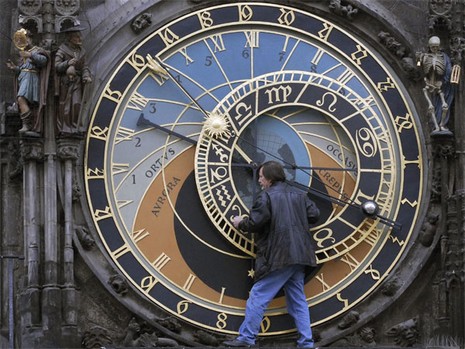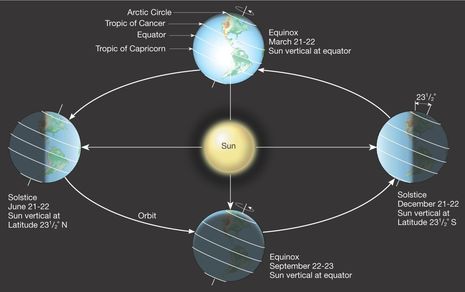Happy New Year, and mind the leap second

That graph represents the teensy weensy difference over recent years between “real” solar system time and the time we oh-so-carefully keep with atomic clocks. As of this morning, real time—i.e. the mean sun dead south or north at noon (at the exact mid longitude of a time zone)—was 6/10ths of a second behind Coordinated Universal Time (UTC or Zulu). You see, relative to the atomic clocks, the earth’s rotation is slowing down a bit—partly, you guessed it, from “tidal friction”—which is why all those corrective leap seconds (spikes) have been applied over the years. Including the one you may not have noticed just after 23:59:59 UTC (6:59:59pm EST) tonight. Time is a slippery thing…
Sure, time is a natural measurement—a day being a single rotation of Earth on its axis, a year being a single orbit of Earth around the Sun—but there are nuances. And, sure, it really is the same time everywhere (relativity aside), but yet we earthlings need Zone and Standard Times to make the days on our particular slice of Earth feel right, not to mention Daylight Saving Times to adjust to our schedules. Anyone who’s messed with celestial navigation can tell you these just hint at how confusing time can get. Heck, even the most real-time of times—Local Apparent Noon, source of the venerable Noon latitude sight—has nuance. The moment the sun is directly south or north at your particular longitude should be directly related to time (time=earth rotation=angle of longitude) but, in fact, the apparent sun slows down and speeds up as much as 14 minutes and 6 seconds during the year relative to the mean sun. This phenomenon is called the Equation of Time and slightly screwed up navigators for centuries.
Wikipedia also has an excellent entry on leap seconds. And, damn, it’s already got a screen capture of tonight’s leap (guess I’m not the only time freak). Plus did you know that the International Earth Rotation and Reference Systems Service (IERS) is for real, not a Monty Python invention? But I had to dig deeper to answer the real question of the night: do leap seconds foul up the GPS system? Well, I was surprised to learn that actual GPS time ignores leap seconds. It and UTC were the same on Jan. 6, 1980, but as there have been 14 leap seconds since then, GPS time is now 14 seconds ahead of UTC (Loran C is 23 seconds ahead). You’ll find the gory details at www.leapsecond.com.
As long as the GPS system keeps ticking, I’m a happy guy. I’m also pleased to learn that despite all our technology and orgs like IERS, we can not predict when leap seconds will be needed. I’m glad my planet is a wee bit random. Come to think of it, I like everything about this planet. And I’m happy to share it with you all. Cheers.














We just need to adjust the time zone here in ME so it does not get dark at 15:30.
Happy and Healthy New Year Ben. Thanks for all you do for us.
Doug
Whatever time it is, thank you for writing Panbo. I think we all look forward to what you’ll write in 2009!
Happy New Year!
True that, Foggy; Maine is way over on the early side of Eastern Standard Time. In fact, the area east of Machias (i.e. east of 67° 30’W) would be an hour earlier if we respected regular zone times more than the geo-political standard times.
In other words, where I live in Camden the average Local Apparent Noon—aside from Equation of Time and Daylight Savings confusions—is just after 11:30 am. East of Machias it’s before 11:30.
But maybe this is why Mainers have such a reputation as up-and-at-’em good workers. Plus of course the whole “puttin’ nuts away for a long winter” thing.
The internal GPS clock does not take leap seconds into account, however, in the nav message (broadcasted every 12.5 minute) the current number of leap seconds is reported. Therefore a gps receiver is able to report UTC correctly by subtracting the reported number of leap seconds from the GPS time. It may be that the receiver reports the wrong time shortly after being switched on, but as soon as the nav message has been received it should be able to report UTC correctly.